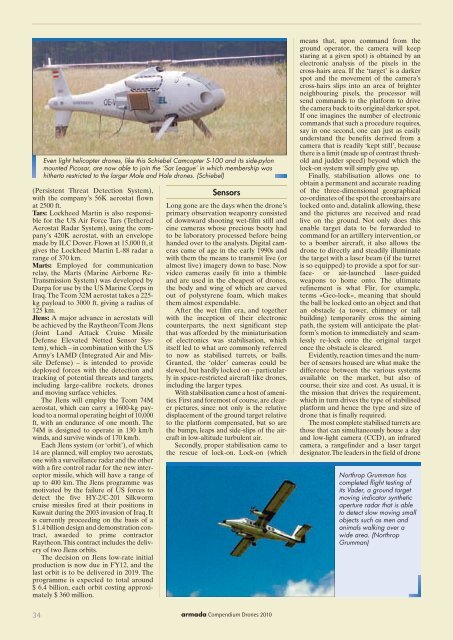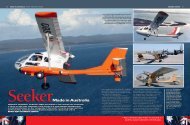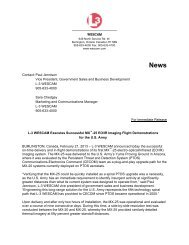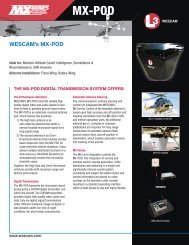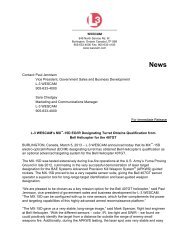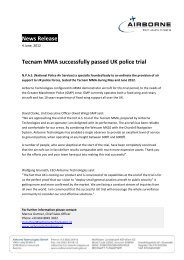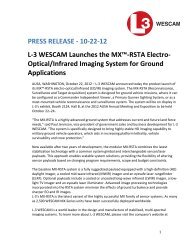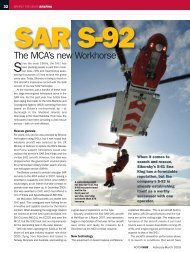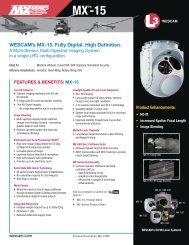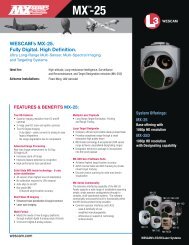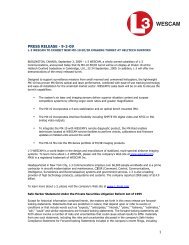Sensors - Wescam
Sensors - Wescam
Sensors - Wescam
You also want an ePaper? Increase the reach of your titles
YUMPU automatically turns print PDFs into web optimized ePapers that Google loves.
Even light helicopter drones, like this Schiebel Camcopter S-100 and its side-pylon<br />
mounted Picosar, are now able to join the ‘Sar League’ in which membership was<br />
hitherto restricted to the larger Male and Hale drones. (Schiebel)<br />
(Persistent Threat Detection System),<br />
with the company’s 56K aerostat flown<br />
at 2500 ft.<br />
Tars: Lockheed Martin is also responsible<br />
for the US Air Force Tars (Tethered<br />
Aerostat Radar System), using the company’s<br />
420K aerostat, with an envelope<br />
made by ILC Dover. Flown at 15,000 ft, it<br />
gives the Lockheed Martin L-88 radar a<br />
range of 370 km.<br />
Marts: Employed for communication<br />
relay, the Marts (Marine Airborne Re-<br />
Transmission System) was developed by<br />
Darpa for use by the US Marine Corps in<br />
Iraq. The Tcom 32M aerostat takes a 225-<br />
kg payload to 3000 ft, giving a radius of<br />
125 km.<br />
Jlens: A major advance in aerostats will<br />
be achieved by the Raytheon/Tcom Jlens<br />
(Joint Land Attack Cruise Missile<br />
Defense Elevated Netted Sensor System),<br />
which – in combination with the US<br />
Army’s IAMD (Integrated Air and Missile<br />
Defense) – is intended to provide<br />
deployed forces with the detection and<br />
tracking of potential threats and targets,<br />
including large-calibre rockets, drones<br />
and moving surface vehicles.<br />
The Jlens will employ the Tcom 74M<br />
aerostat, which can carry a 1600-kg payload<br />
to a normal operating height of 10,000<br />
ft, with an endurance of one month. The<br />
74M is designed to operate in 130 km/h<br />
winds, and survive winds of 170 km/h.<br />
Each Jlens system (or ‘orbit’), of which<br />
14 are planned, will employ two aerostats,<br />
one with a surveillance radar and the other<br />
with a fire control radar for the new interceptor<br />
missile, which will have a range of<br />
up to 400 km. The Jlens programme was<br />
motivated by the failure of US forces to<br />
detect the five HY-2/C-201 Silkworm<br />
cruise missiles fired at their positions in<br />
Kuwait during the 2003 invasion of Iraq. It<br />
is currently proceeding on the basis of a<br />
$ 1.4 billion design and demonstration contract,<br />
awarded to prime contractor<br />
Raytheon. This contract includes the delivery<br />
of two Jlens orbits.<br />
The decision on Jlens low-rate initial<br />
production is now due in FY12, and the<br />
last orbit is to be delivered in 2019. The<br />
programme is expected to total around<br />
$ 6.4 billion, each orbit costing approximately<br />
$ 360 million.<br />
<strong>Sensors</strong><br />
Long gone are the days when the drone’s<br />
primary observation weaponry consisted<br />
of downward shooting wet-film still and<br />
cine cameras whose precious booty had<br />
to be laboratory processed before being<br />
handed over to the analysts. Digital cameras<br />
came of age in the early 1990s and<br />
with them the means to transmit live (or<br />
almost live) imagery down to base. Now<br />
video cameras easily fit into a thimble<br />
and are used in the cheapest of drones,<br />
the body and wing of which are carved<br />
out of polystyrene foam, which makes<br />
them almost expendable.<br />
After the wet film era, and together<br />
with the inception of their electronic<br />
counterparts, the next significant step<br />
that was afforded by the miniaturisation<br />
of electronics was stabilisation, which<br />
itself led to what are commonly referred<br />
to now as stabilised turrets, or balls.<br />
Granted, the ‘older’ cameras could be<br />
slewed, but hardly locked on – particularly<br />
in space-restricted aircraft like drones,<br />
including the larger types.<br />
With stabilisation came a host of amenities.<br />
First and foremost of course, are clearer<br />
pictures, since not only is the relative<br />
displacement of the ground target relative<br />
to the platform compensated, but so are<br />
the bumps, leaps and side-slips of the aircraft<br />
in low-altitude turbulent air.<br />
Secondly, proper stabilisation came to<br />
the rescue of lock-on. Lock-on (which<br />
means that, upon command from the<br />
ground operator, the camera will keep<br />
staring at a given spot) is obtained by an<br />
electronic analysis of the pixels in the<br />
cross-hairs area. If the ‘target’ is a darker<br />
spot and the movement of the camera’s<br />
cross-hairs slips into an area of brighter<br />
neighbouring pixels, the processor will<br />
send commands to the platform to drive<br />
the camera back to its original darker spot.<br />
If one imagines the number of electronic<br />
commands that such a procedure requires,<br />
say in one second, one can just as easily<br />
understand the benefits derived from a<br />
camera that is readily ‘kept still’, because<br />
there is a limit (made up of contrast threshold<br />
and judder speed) beyond which the<br />
lock-on system will simply give up.<br />
Finally, stabilisation allows one to<br />
obtain a permanent and accurate reading<br />
of the three-dimensional geographical<br />
co-ordinates of the spot the crosshairs are<br />
locked onto and, datalink allowing, these<br />
and the pictures are received and read<br />
live on the ground. Not only does this<br />
enable target data to be forwarded to<br />
command for an artillery intervention, or<br />
to a bomber aircraft, it also allows the<br />
drone to directly and steadily illuminate<br />
the target with a laser beam (if the turret<br />
is so equipped) to provide a spot for surface-<br />
or air-launched laser-guided<br />
weapons to home onto. The ultimate<br />
refinement is what Flir, for example,<br />
terms «Geo-lock», meaning that should<br />
the ball be locked onto an object and that<br />
an obstacle (a tower, chimney or tall<br />
building) temporarily cross the aiming<br />
path, the system will anticipate the platform’s<br />
motion to immediately and seamlessly<br />
re-lock onto the original target<br />
once the obstacle is cleared.<br />
Evidently, reaction times and the number<br />
of sensors housed are what make the<br />
difference between the various systems<br />
available on the market, but also of<br />
course, their size and cost. As usual, it is<br />
the mission that drives the requirement,<br />
which in turn drives the type of stabilised<br />
platform and hence the type and size of<br />
drone that is finally required.<br />
The most complete stabilised turrets are<br />
those that can simultaneously house a day<br />
and low-light camera (CCD), an infrared<br />
camera, a rangefinder and a laser target<br />
designator. The leaders in the field of drone<br />
Northrop Grumman has<br />
completed flight testing of<br />
its Vader, a ground target<br />
moving indicator synthetic<br />
aperture radar that is able<br />
to detect slow moving small<br />
objects such as men and<br />
animals walking over a<br />
wide area. (Northrop<br />
Grumman)<br />
34 armada Compendium Drones 2010


